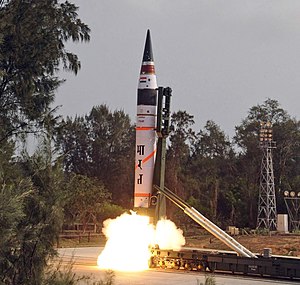烈火-5洲际弹道导弹
烈火-5洲际弹道导弹为印度国防研究和发展组织(DRDO), 研制的固态燃料洲际弹道导弹,可对5,000公里以外的目标进行攻击[2][3][10],该导弹于2012年4月19日在奥里萨邦惠勒岛试射成功[14][15][16][17][18]。
| 烈火-V | |
|---|---|
 烈火-5洲际弹道导弹于2012年4月19日试射 | |
| 类型 | 洲际弹道导弹[1][2][3] |
| 原产地 | |
| 服役记录 | |
| 服役期间 | 2014年[4] (Testing) |
| 使用方 | 印度陆军 |
| 生产历史 | |
| 生产商 | 印度国防研究和发展组织(DRDO), 印度动力公司 (BDL) |
| 基本规格 | |
| 重量 | 50,000千克(110,000英磅)[5] |
| 长度 | 17.5米(57英尺)[6] |
| 直径 | 2米(6.6英尺) |
| 最大射程 | 5,000-8,000千米(5,000英里)[7][8][9][10] |
| 弹头量 | 1.1 ton/1000 kg[11] |
| 发动机 | 三段固态燃料推进 |
| 速度 | 24马赫 [12] |
| 发射平台 | 8 x 8 Tatra卡车、铁路平台(Canisterized missile package) [13] |
| 运输 | 道路或铁路运输 |
简介
编辑该型号最早由印度前国防研究与发展组织主任纳塔拉吉于2007年宣布,其作为烈火-3弹道导弹的升级版本,并命名为烈火-5弹道导弹,最初计划于4年内完成[19],射程约5,000公里[20]。
相较于较早期的烈火系列弹道导弹,烈火-5采用储运发射箱,在运输及储存上更为便利。[6]
性能
编辑推进
编辑烈火-5洲际弹道导弹为三段式固态燃料,第三级配置复合材料发动机匣。在许多设计上延续了烈火-3弹道导弹,而导弹由两段增为三段,能够增加射程并减轻重量,射程较烈火-3的3,500公里增加1,500公里[21][22]。其中两级使用复合材料[23],也采用了环式激光陀螺等先进技术[24]。
多目标重返大气层载具
编辑烈火-5洲际弹道导弹配备多目标重返大气层载具,单枚导弹可装载2-10枚核弹头[25],各弹头可攻击数百公里范围内的数个目标,也能够多枚弹头攻击单一目标[21]。
参见
编辑参考文献
编辑- ^ 印度再次成功发射“烈火—5”弹道导弹 互联网档案馆的存档,存档日期2016-03-04.,亚太日报,2013年9月16日
- ^ 2.0 2.1 Eyeing China, India to enter ICBM club in 3 months. The Times of India. 17 November 2011 [2012-04-19]. (原始内容存档于2012-04-19).
- ^ 3.0 3.1 With Russian help, India to enter ICBM club soon. Dailypioneer. 8 October 2011 [2012-04-19]. (原始内容存档于2012-04-26).
- ^ DRDO Lab Develops Detonator for Nuclear Capable Agni-V Missile As It Gets Ready For Launch. Defencenow. 17 January 2012. (原始内容存档于2012年1月22日).
- ^ Preparations apace for Agni V launch. [2012-04-19]. (原始内容存档于2011-09-09).
- ^ 6.0 6.1 DRDO plans to test 10 missiles this year. The Times of India. 27 January 2011 [19 October 2011]. (原始内容存档于2013-05-01).
- ^ India developing 5,000 km-range Agni missile. Chennai, India: The Hindu. 25 March 2011 [2011-03-26]. (原始内容存档于2011-04-03).
- ^ Missiles of the World: Agni 4/5. Missile Threat. 19 July 2010 [23 February 2012]. (原始内容存档于2012年2月2日).
- ^ T. S. Subramanian. Preparations apace for Agni V launch. Chennai, India: The Hindu. 23 July 2011 [2011-07-24]. (原始内容存档于2011-09-09).
- ^ 10.0 10.1 Agni-4/5. Missile Threat. 19 July 2010. (原始内容存档于2012年2月2日).
- ^ Agni-V getting ready for launch. [2012-04-19]. (原始内容存档于2014-09-03).
- ^ India’s most potent missile Agni V all set for launch. [2012-04-19]. (原始内容存档于2012-07-28).
- ^ Y. Mallikarjun, Agni-V design completed; to be test-fired in 2010 (页面存档备份,存于互联网档案馆), The Hindu, 27 November 2008
- ^ 存档副本. [2012-04-19]. (原始内容存档于2012-04-22).
- ^ 存档副本. [2012-04-19]. (原始内容存档于2021-03-14).
- ^ 存档副本. [2012-04-19]. (原始内容存档于2012-12-05).
- ^ 存档副本. [2012-04-19]. (原始内容存档于2012-04-24).
- ^ 存档副本. [2012-04-19]. (原始内容存档于2012-07-30).
- ^ Press Trust of India. Next variant of Agni to be inducted within 4 years: Scientist. [26 September 2007]. [失效链接]
- ^ Don't Even Think About It. Foreign-policy. [23 February 2012]. (原始内容存档于2013-07-30).
- ^ 21.0 21.1 What makes 5000 km range Agni-5 missile deadlier. News.rediff.com. 12 October 2009 [20 October 2011]. (原始内容存档于2021-01-25).
- ^ DRDO readying design for 5,000 km-range Agni-V (页面存档备份,存于互联网档案馆). Hindu.com (2008-05-10). Retrieved on 2012-04-20.
- ^ DRDO to make missiles lighter, cost-effective. thehindubusinessline.com (2008-09-24)
- ^ Agni-V design completed; to be test-fired in 2010 (页面存档备份,存于互联网档案馆). Hindu.com (2008-11-27). Retrieved on 2012-04-20.
- ^ India test fires ICBM Agni V. IndiaVoice. April 19, 2012 [20 April 2012]. (原始内容存档于2013年2月18日).